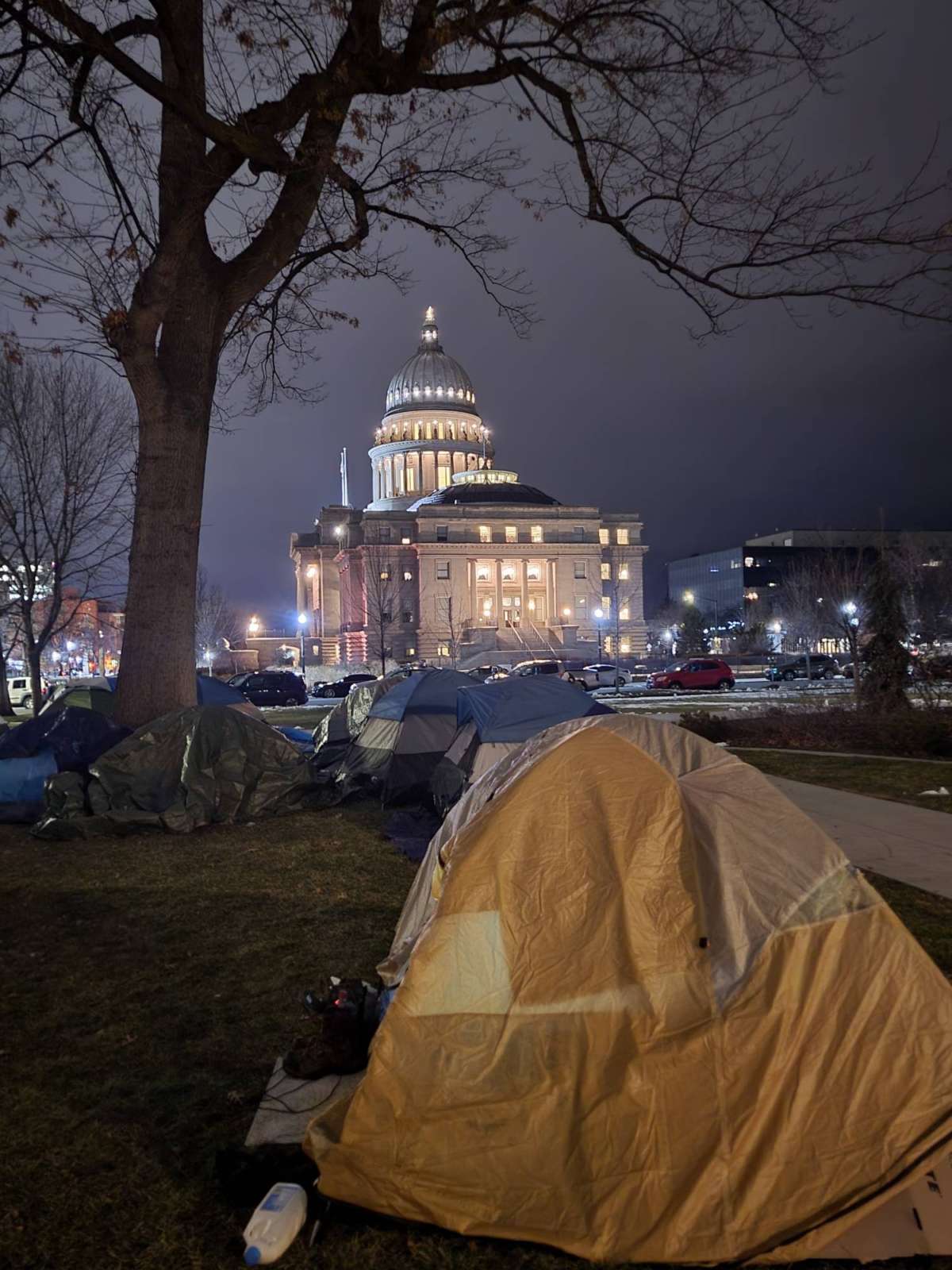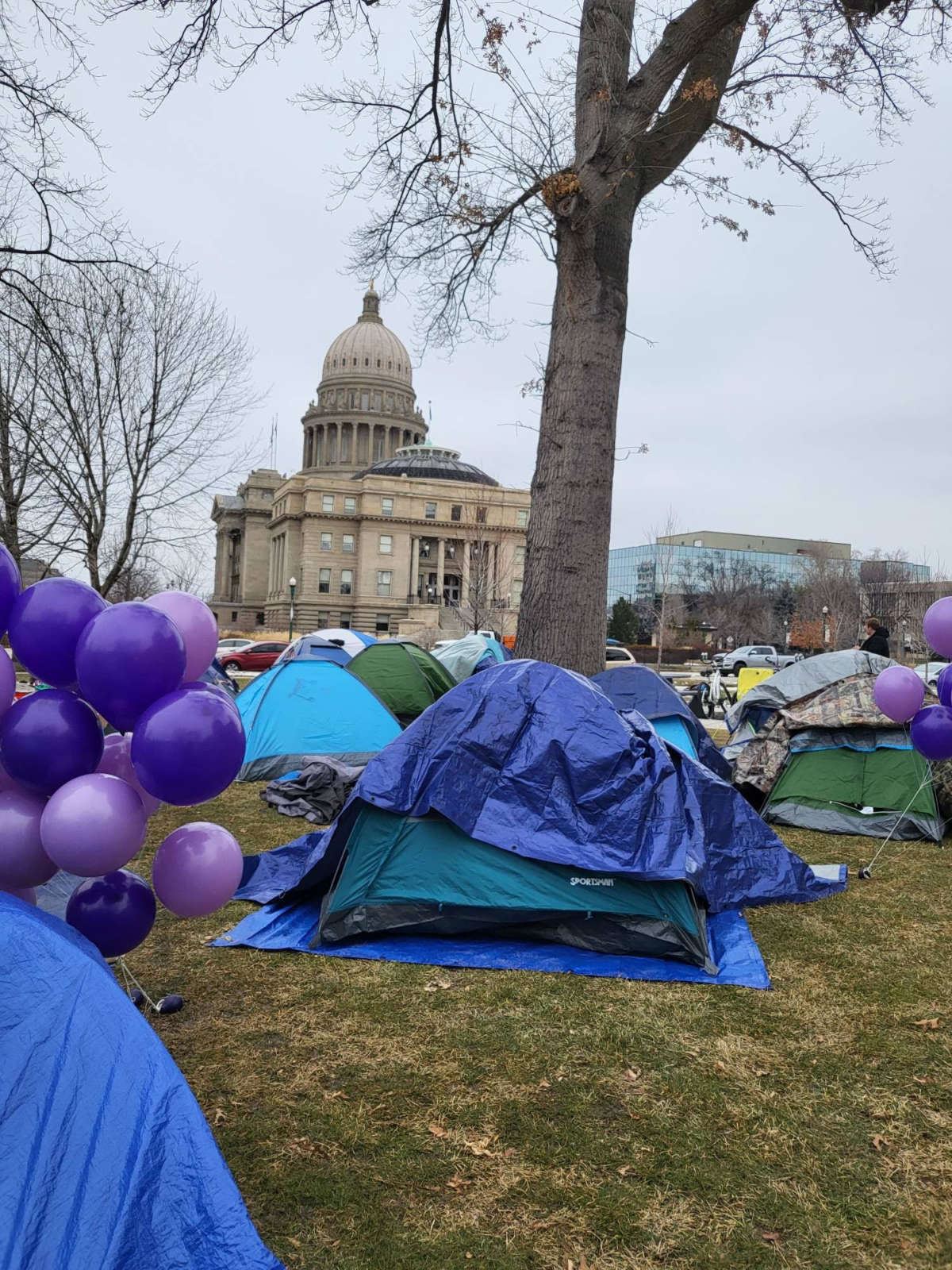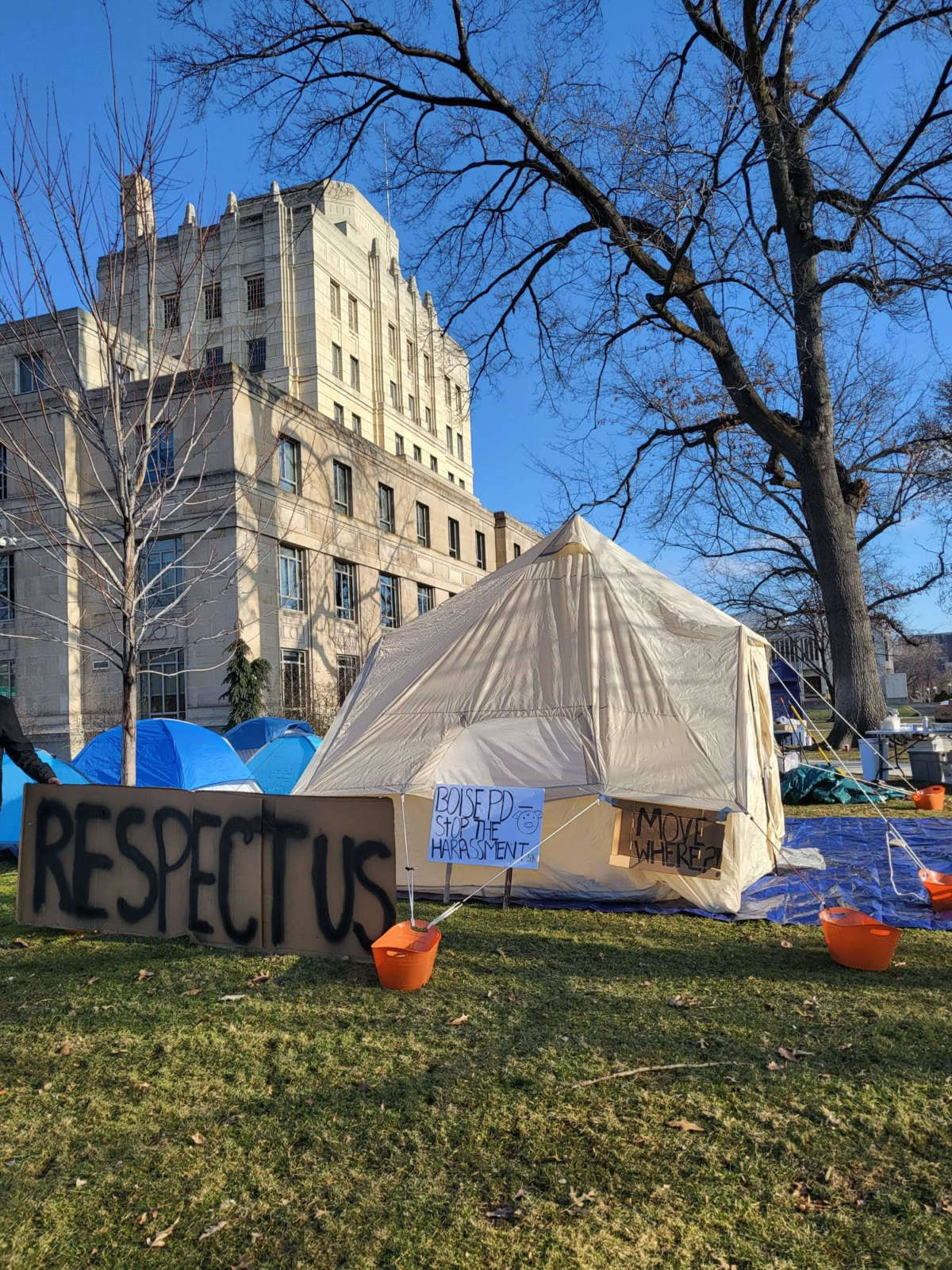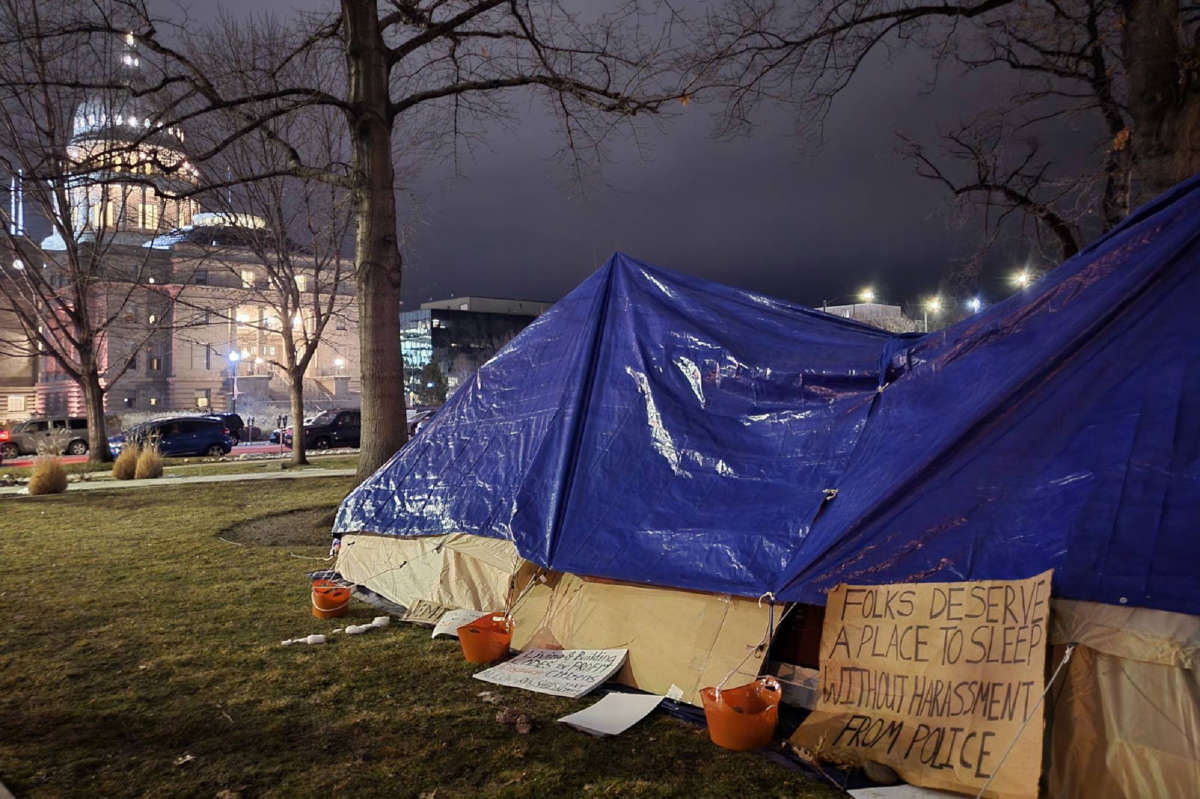The injustice of homelessness — a human rights crisis of immense proportions in the United States — is on stark display in Idaho’s modestly sized capital of Boise, just as it is across the nation. While the city might not come to mind when one envisions the sprawling atrocity of homelessness, it is a 2018 court battle originating in Boise that has had a defining influence on homelessness policy far beyond the Idaho border.
After passing ordinances that targeted the city’s population of people experiencing homelessness, the City of Boise faced a court challenge from six unhoused plaintiffs. The outcome was Martin v. City of Boise, a landmark 2018 ruling by the Ninth Circuit Court of Appeals that barred the criminalization of conducting life-sustaining activities on the street, in the absence of alternative shelter. Although advocates had reason to cheer this apparent progress, the decision has ultimately served more as a reiteration of their moral claims than as a practical guarantor of the rights of the unhoused.
Evasion of Martin v. Boise’s mandate has been the norm in cities within the court’s broad remit. This is just as much the case in Boise itself, where the city has found numerous ways to violate the spirit, if not the letter, of the Ninth Circuit decision — perpetuating the kinds of criminalization, displacement and harassment that are the favored responses of power to the plight of marginalized people.
In this frigid winter, the mistreatment of Boise’s thousands of unhoused people has only intensified, according to activists. Housing remains scarce and unaffordable, while overcrowding and restrictions in shelters have kept many on the street, and in acute hardship. Local advocates, organizers with Boise Mutual Aid and members of the unhoused have responded by joining together in coalition, spearheading an Occupy-style protest on the grounds of the Idaho State Capitol Mall. Now, over a month in, they’ve dealt with dismal conditions and repeated provocations from police and the far right alike.
A Cycle of Impoverishment
Bella Bounty, an organizer with Boise Mutual Aid, who asked to be identified by a pseudonym to avoid attention from the state and the far right, told Truthout that in the last couple of years, activists “observed something which has really escalated since Martin v. Boise: constant police harassment.” Tickets for minuscule offenses are handed out freely. Those unable to challenge their citations are often later arrested, held on failure-to-appear warrants. It’s a punishing cycle that ensures their impoverishment. Police also profile and target people living in cars and order their vehicles to be ticketed and towed; unable to pay the lot fees, many people lose their only shelter as a result.
Jon Rogers, who has been on the streets in Boise since arriving from Louisiana in 2016, alleges systematic persecution in the legal system. “They’d come arrest you, trump the charges up, make you pay an exorbitant amount of bail to get out. But when you go to court, guess what: They drop it. Or they drop it to a lesser offense — much lesser. So, you’re not gonna contest it. You’re gonna take your lick,” Rogers told Truthout. “You can’t do anything about it, because now it’s on your record.… They’re just stealing our money. It’s extortion.”
Members of the unhoused community in Boise are all too familiar with these kinds of torments. Teddy B. is a veteran and one-time homeowner from Missouri who asked to be identified by his surname’s initial. He has been unhoused in Boise for two and a half years, and has faced longer stints on the street in his past. “My experience with [the police] has been pure harassment,” he said bitterly. “Almost daily, they come down and confiscate sleeping bags, propane heaters, blankets, pillows…. They’ve taken my dog’s service vest; they’ve taken multiple sleeping bags. They took a whole backpack of my dog’s stuff.”
“If I were to act the way the Boise troopers and the State Police of Idaho act when I was in the Marine Corps overseas, I would still be in the brig for it,” he said, suggesting that he believed such behavior would have landed him in military prison.
Lone campers, forced to hide from police, face an increased risk of assault, as well as hypothermia. In the winter, they must choose between the lethal cold and the very real dangers posed by heater fumes and tent fires. (Rogers, who has a heart condition, described a near-death experience: carbon monoxide inhalation that triggered a heart attack, all from struggling to stay warm.) And, community members allege, when police come upon the unhoused, they often relentlessly ransack their tents and confiscate all belongings, including cold-weather gear —which, in an Idaho winter, can have serious consequences.
Search and seizure rights seem to be no deterrent, say local members of the unhoused. “The reason they don’t need a warrant is they call it a ‘welfare check,’” Teddy B. says, claiming that cops often attempt to check the “welfare” of unoccupied tents, which they then throw in a dumpster. Then, he alleges, “the Boise police sit and wait around the corner for nighttime for you to come to retrieve your shit, and they charge you with a crime there. It’s ridiculous. The system is designed to turn you into a criminal.” Rogers described similar harassment, saying, “They’ve been known to take people’s personal belongings and throw them in a woodchipper.”
Reached for comment on these allegations, the Boise Police Department responded:
“Officers with the Boise Police Department work closely with people experiencing homelessness in our community to get to know them, keep them safe, and understand their individual needs. Officers will offer and encourage those setting up tents or temporarily shelters to use one of the city’s shelters or help connect them with other services. If items are abandoned in public spaces, officers will document the items and leave a letter explaining that the items will be picked up in 24 hours if they are still there. The letter also has information about where people can collect the items later if they want.”
Rogers also related to Truthout how self-appointed local vigilantes seem to make a hobby of combing through natural areas to locate and report campers. To the same ends, says Bounty, police have gone as far as to deploy drones with infrared cameras to hunt down tents by sleepers’ heat signatures. (This unsettling variety of surveillance is growing more commonplace nationwide.)

The capitol mall protest against these conditions dates to earlier this winter, after Boise activists, seeking to provide their neighbors some relief, were able to secure the temporary use of a local nonprofit’s building as a warming shelter. (Just one of the countless heated buildings that sit empty in the cold months, while nationwide, around 700 unhoused people freeze to death annually.) An ad hoc community organization quickly sprung up as donations from local supporters began to arrive. From there, organizers developed plans to expand the protest and make a stand against an unacceptable status quo at the capitol. “Everyone was fired up with renewed hope and dignity,” said Bounty.
The effort took on the defiant, if slightly unwieldy, moniker “Operation Hope Ain’t Goin’ Nowhere.” An initial protest site on city property was ousted by police within hours. Undeterred, the protesters promptly reassembled their occupation on the state land of the capitol mall, in the same location as the Occupy Boise protest of last decade. Since mid-January, the occupation has stood through vicious cold, reprisals by the state and the intrusion of reactionary groups. Regular attempts at eviction have been fended off by resistance from the impromptu community. Their tenacity is proportional to the scale of the harm that is the status quo, inflicted daily in Idaho and across the country: flagrant, barely restrained cruelty and structural violence.
De Jure Victory, De Facto Injustice
To understand that status quo — why cities like Boise are able to continue, or intensify, punishments despite Martin v. Boise — it’s important to understand the serious shortcomings of the 2018 decision. Following its passage, initial hopes were high. A dozen years of litigative efforts by the six unhoused plaintiffs and their defense had culminated in the Ninth Circuit’s historic ruling, setting a robust new precedent. The judicial opinion states that if there are no “practically available” options for shelter, “the Eighth Amendment prohibits the imposition of criminal penalties for sitting, sleeping, or lying outside on public property for homeless individuals who cannot obtain shelter.”
The ruling was a resounding affirmation of the claims that advocates had been making for years: punishing people on the street for their existence is indeed “cruel and unusual,” per the Eighth Amendment. Because of the sprawling jurisdiction of the appellate court — Alaska, Hawaii, Washington, Montana, Idaho, Oregon, California, Nevada and Arizona are within its purview — the Martin decision came as a resounding affirmation of human rights. Those states, the western and noncontiguous U.S., contain disproportionately large populations of people experiencing homelessness. The precedent is binding in all of them, and is persuasive in courts nationwide.
“Quality-of-life” ordinances like sit/lie laws (which ban those activities on sidewalks) and anti-camping measures have long been marshaled to criminalize the mere presence of the homeless. These policies furnish a pretense for ticketing and harassment, often in tandem with violent sweeps. In the latter, cities and police forcibly uproot tent communities or other shelters of the unhoused whenever they see fit — often at the behest of business- and home-owning complainants. These counterproductive practices do nothing but exacerbate the problem and further immiserate the immiserated.

The slackening of enforcement that followed Martin v. Boise seemed, at first, a promising indicator. The Seattle Times cites a few examples: “The Honolulu City Council passed anti-camping laws only to have the police say they were unenforceable. In Lacey, Washington, the city passed anti-camping laws but acknowledged it couldn’t enforce them until it opened a shelter. In Costa Mesa, California, the city waited to enforce the rules until it could open a 50-bed shelter at a church in April.” This pattern was replicated across the Ninth Circuit’s jurisdiction.
“When we first got here,” Rogers told Truthout, “You couldn’t sleep on the street. They’d harass you, put you in jail. I had a camping ticket — a ticket for camping. Now they can’t do that, because of the decision by Martin v. Boise.” However, Martin’s tangible impacts were ultimately limited; punitive responses tended to transform, rather than abate. Though rightly hailed as a significant step, the decision was far from a panacea. Three years on, the ruling in Martin v. Boise has proven to be chiefly an ideological victory rather than a practical one.
Rogers elaborated on the shift: “Soon after Martin v. the City of Boise, instead of giving out camping tickets and the like, now it’s disturbing the peace, sleeping without permission. It’s also disorderly conduct tickets, ‘debris on roadside’.… If you’ve got your bike anywhere near a sidewalk, you’re ‘obstructing’ the sidewalk.… A friend of mine, he got a ticket for ‘debris on the roadway.’ He was the debris.” Pretexts for punishment are readily available and eagerly used.
Shelter at the Price of Autonomy
It’s also easy to see a crucial ambiguity in the judicial opinion’s language: What constitutes “practically available shelter”? The putative provision of open beds in brick-and-mortar shelters (as well as “sanctioned encampments,” i.e., state-approved tent or tiny home groupings), allows for technical compliance, and therefore the redeployment of punitive measures: citations and sweeps among them.
But what’s poorly understood in the public mind — and often ignored in reportage — is that shelters can, for many reasons, be far less viable an option than they appear. Many, referred to as “high-barrier” or “carceral” shelters, impose burdensome requirements such as restrictions on entry and exit times, as well as constraints on personal belongings, pets and companions. People may be separated by gender — even from their families. Other precluding factors include substance use bans or mental health requirements, or insufficient disability accommodations. (The Department of Housing and Urban Development explicitly acknowledges these impediments.)
Bounty says that high barriers are the norm in Boise: “They just treat people like children. It’s carceral: You will go to bed at this time, you will eat at this time, you can’t leave after this time. People are just treated very poorly, so there are a lot of people that are electing to not go there.”
Boise’s shelters are almost all run by religious groups, with some so strict as to ban curse words. Local shelters also “work closely with the city and police, so they’ll turn people over,” Bounty says, adding, “They’ll call the cops on people.” Such conditions — which have been described as “prison-like” — are widespread in U.S. shelters and sanctioned encampments.
Disturbingly, shelters nationwide have also been found to practice active discrimination against LGBTQ+ entrants. Trans people are a regular target for exclusion. (The Trump administration unsuccessfully attempted to codify this type of bigotry.) Boise’s primary men’s shelter had at one point stipulated that, to gain entry to a sobriety program, applicants had to give a written answer to a probing question: inquiring whether they were willing to adhere to an “acceptable” heterosexual lifestyle. A 2019 report by Idaho News 6 quoted the CEO of the shelter as explaining that, if someone declined to say so, then, “There would have to be further conversation…. Do you intend to be flirting with the other women in the program and trying to set up dates?… While they’re in the program, we’re going to expect them to adhere to that.… We want people to understand from the beginning that this is how the program is going to be.”
Rogers agreed that the shelters are unsuitable for a number of reasons. In some, he claims, “You gotta pray to the Lord before you walk in, and if you don’t believe in Jesus, you ain’t going in. If you curse, they can just throw you out for no reason whatsoever.” To make matters worse, he alleges, “They’ve got bedbugs everywhere, they can’t get rid of them.”
Conditions and restrictions notwithstanding, shelters are woefully overcrowded. Interfaith Sanctuary (which describes itself as “the only low-barrier shelter in Boise”) has been regularly reaching “crisis level.” Interfaith Sanctuary is the most accepting: “Anyone can stay there regardless of their sobriety, sexual orientation and gender identity as long as they follow the behavior rules of the shelter,” writes Margaret Carmel for BoiseDev. But crowds mean that a more amenable shelter is not always an option.
Rogers notes that the general conditions in shelters can intensify both mental and physical health issues. “What about somebody who suffers from social anxiety like I do?” says Rogers. “It’s chock-a-block. You can’t walk two feet without either being in front of somebody or running into somebody.” Related are some major concerns about COVID. “Nobody’s wearing masks. Nobody’s getting tested,” Teddy B. alleges. “You walk by the shelter at night, and you can hear the echo of people coughing, their lungs rattling. The virus is just spreading through the air.… Do I go in there and be warm, or do I take my chances out here?”
One can understand why some might prefer the street — and why many view the shelters as no real alternative at all.
Occupational Hazards
Participants in the Occupy-style protest now installed on the Idaho State Capitol Mall expresses a mounting sense of outrage at this forced choice between the intolerable conditions on the streets and in the shelters alike. This winter, unhoused Boiseans and activists have been enduring temperatures that have dropped as low as 7 degrees Fahrenheit. (While encampments are disallowed throughout the city and are explicitly prohibited on the capitol mall, a court ruling dating to 2011 “allows activists to use tents as part of a demonstration,” reports AP News.)
“There’s been a lot of internal organizing happening to make things go as smoothly and safely as possible for everyone there,” says Bounty, “but the cops take everything.” Police have found reason to make arrests of demonstrators, and the state has denied their use of portable bathrooms. The organization Idaho Legal Aid asserts that these abuses violate both First Amendment and Eighth Amendment rights — a basis for a possible future contestation in the courts.

“Operation Hope Ain’t Goin’ Nowhere” has also been subjected to aggression from the local far right, facing attacks from groups like the “Idaho Liberty Dogs.” Around 70 showed up to a counterprotest, where jeering reactionaries hurled insults and projectiles. Others pitched in by threatening violence online: read one comment, “Organize 200[,] 300 folks with [assault rifles] to clean up.”
Joining them in spirit was Idaho’s Lt. Gov. Janice McGeachin, who issued repeated calls for police to destroy the protest. Even authorities like the police director and the attorney general’s office called her statements “counterproductive” and “unhelpful,” respectively. (McGeachin’s other notable endeavors include hobnobbing with white nationalists and Holocaust deniers.)
Despite all the haranguing and threats, the protest has remained knit together by determination, regular potlucks and expressions of solidarity from locals. “The reaction and participation from the community is way beyond what we would have expected,” Bounty said. “It’s very refreshing and beautiful to see how easily people do step into that model of community care.”
Sidestepping the Issue
Boise, for all its inhumane treatment of the unhoused, is far from exceptional in that regard. The 2018 passage of Martin v. Boise left numerous West Coast city governments scrambling to meet the conditions of its mandate. Contestation was attempted; in 2019, dozens of municipalities appealed to the Supreme Court, and were denied — the decision stood. What followed was a patchwork of policy approaches determined by local power structures, existing statutes and resource availability.
There were indeed noticeable cessations of repressive measures (if often temporary ones) as a result of the ruling, and, for all their problems, the increased deployment of sanctioned encampments has provided marginal relief to some. However, the porosity of the ruling meant that it was easily circumvented. Its applicability is fairly narrow, and there are numerous criminalizing ordinances that have gone unaffected: Laws against trespassing, disorderly conduct, littering, and more can be used to continue or bolster enforcement. (In fact, an attorney for the City of Boise, one of the legal team that appealed the decision in 2019, published a report on how cities can accomplish just that.)
A press release on the capitol mall protest from the Western Regional Advocacy Project, an unhoused rights group, explains how, “In response to Martin v. Boise, local municipalities across the country have responded with ‘whack a mole’ strategies to get around the court’s stated intent.” Any unhoused people that balk at carceral shelter conditions might soon find themselves branded “service-resistant” — and therefore, in the eyes of the state, exposed to and worthy of punishment.
The ease of skirting the ruling is illustrated by cases like that of the city council in Berkeley, California, which backed away from one penalty proposal for street camping and related activities — only to ram through another regulation banning placement of “objects” that prevent use of “any portion of sidewalks.” The intent is transparent. In Seattle, the city attorney was quick to point out that because Seattle’s anti-camping laws are not outright bans (rather, they are circumstantial restrictions), the city was exempted from the decision by changing nothing at all.
In Washington State, as the Municipal Research and Services Center has catalogued, patchwork half-measures have coexisted with continued criminalization. For instance, the Inlander (a community newspaper based in Spokane, Washington) paraphrases attorney Jose Trejo as asserting that Spokane “has been more careful in following the Boise decision than other cities, since it’s tried to add shelter space and has officers call in to make sure beds are available before issuing citations.” The nearby town of Spokane Valley, meanwhile, tested the ruling’s scope by going ahead with a camping-ban ordinance that “keeps a permanent ban in three locations no matter if shelter space is available or not.” Much as in Boise, activists demonstrated against encampment removal in front of Spokane’s city hall in response.
The pressure on cities to enable the resumption of enforcement by providing shelter has led to the proliferation of half-measures. Modesto, California, quickly sought to “establish more shelter beds while pursuing a series of stopgap measures, such as allowing an encampment in a park and later establishing a city-sanctioned encampment,” wrote Gregory Scruggs for U.S. News & World Report. But now, “Modesto has gone back to enforcing its no camping law.” There and elsewhere, the obligations of the ruling were rapidly met so that repression could continue apace, the problem unsolved. Beneath the complex set of West Coast policy responses (which vary in effectiveness, humaneness and degree of good faith) lies the reality: No sanctioned encampment, no mere treatment of symptoms and certainly no criminalization or displacement will resolve this vast structural crisis.
The Solution at Hand
In responding to homelessness, cities and police reflexively turn to citation, eviction and incarceration. This is not only because they aspire to cruelty (though that can be true as well), but also because incentives exist to appease privileged constituents: the desire of homeowners to erase “eyesores,” the desire of business to avoid disruption — to remove “undesirables” they see as inimical to profit. The privileged find it distasteful that they are glancingly exposed to the misery of others. The state, its priorities set by power and capital, attentively responds. “I’m discriminated [against] by members of this community because I’m homeless,” says Teddy B., “because it’s unsightly and goes against the norm.”
“Every time we get one step ahead, they set us back 10 steps,” he went on. “The system is broken and inhumane, and it’s designed to stay that way.… The whole system of the United States is broken.”
Rogers similarly expressed frustration at the difficulty of mere survival, his fears of further health problems, the toll of the incessant theft and punishment exacted by the state. “It’s a never-ending battle.… I don’t know why they squeeze blood out of a turnip, but they seem to have a knack for it.”
But in resistance efforts like those staged by Boise Mutual Aid and others at the capitol mall, he does see reason for hope, at least in glimmers. Since the beginning, what has given life to the protest “is the camaraderie. And it still is — the community still based there. It is, I hope, making a difference.”
As Bounty reiterates, solidarity has sustained activists’ efforts. “There’s a huge, massive lack of accessibility to resources that the city, the state is not fulfilling. But the community, through mutual aid, has come together” to fill the gaps. In fact, such efforts have flourished statewide. “I think it’s vital that we start to lean into collective care instead of competing with each other.… I think that’s something that humans intrinsically tend towards.”
It is abundantly clear that inequality, especially in housing, is the progenitor of homelessness; it is practically self-evident that the solution to homelessness is homes. Activists repeat this refrain again and again, and for good reason. The unhoused population in Boise has risen in direct correlation to its shortage of affordable housing.
Rogers’s words speak to the core of this overwhelming American injustice: “There’s not enough houses…. What do you want to do — you want to fix the problem? Or you just want to kill all of us off? The problem is not homeless people. It’s the homelessness. Don’t try to eradicate the homeless people. Just eradicate the homelessness.”
Media that fights fascism
Truthout is funded almost entirely by readers — that’s why we can speak truth to power and cut against the mainstream narrative. But independent journalists at Truthout face mounting political repression under Trump.
We rely on your support to survive McCarthyist censorship. Please make a tax-deductible one-time or monthly donation.
